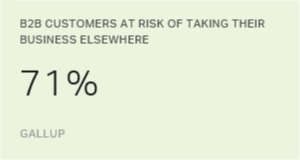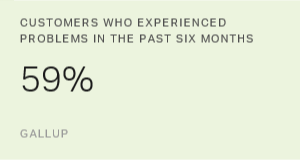Story Highlights
- Web-based customer experience platforms are designed for B2C customers
- B2B relationships are complex & success means reading between the lines
- B2B customer feedback info should be specific, high value and timely
There seems to be an app to fix every problem these days. But these technical solutions -- while appealing -- don't always provide the qualitative feedback that business-to-business relationships need. This lack of information is especially apparent when B2B companies try to gather insights from feedback that increases growth the same way B2C companies do.
For instance, web-based surveys are valuable for improving the transactional customer experience. Web-based surveys collect a considerable amount of feedback, helping leaders understand trends in the organization.
However, in B2B relationships, web-based transactional surveys don't have the same effect. C-suite leaders in B2B companies frequently complain that these surveys offer too much information and not enough insight.
There are four main reasons web-based surveys are less effective for B2B customers:
B2B customers are a collection of many stakeholders.
Unlike B2C end users, B2B customers are a group of people with different roles.
It's increasingly unusual for the primary B2B customer to be a single person, so B2B companies need to be familiar with each stakeholder in the customer organization to understand the current and future state of the B2B relationship.
The most important B2B customers are typically executives who rarely respond to web surveys.
Typically, technology platforms only collect customer feedback via web surveys.
When all voices are equal, such as they are in a B2C relationship, web surveys can deliver substantial feedback quickly.
However, in a B2B relationship, many stakeholders determine your fate, and not all of them have the same influence when it comes to supplier/vendor relationships. An approach that values the time and input of prominent client stakeholders is vital to gaining their responses.
B2B relationships are complex, and success or failure often hinges on the ability to read between the lines and recognize the nuances of the interactions with customers.
Web instruments don't allow for this detailed level of understanding of B2B relationships.
B2B relationships are multidimensional and can evolve depending on the business climate, stakeholder turnover or customer politics.
As a seller, deciphering customer signals and their business environment can make a difference in winning or losing a deal -- and web surveys and technology platforms cannot get this type of information.
By design, tech platforms with web survey capability excel at collecting a lot of information quickly from large groups of people, and the more standardized the group, the better.
Using web surveys to assess many people is valuable for retailers, banks and similar organizations. But it comes at the expense of a sensitivity to the nuances of the customer relationship, so it does not translate to B2B relationships.
Data and reporting that result from web surveys are not aligned to make a difference in B2B organizations.
Leaders often see the results of web-based surveys in dashboards and scorecards that function effectively as performance management and ranking systems but only when there are sufficient data to collect and the value of each respondent is relatively equal.
When leaders manage individual and team performance using these metrics, the customer experience should improve. But in the B2B environment, this level of comparability between accounts is more difficult to achieve and manage.
Action alerts and problem management are core components of web-based surveys, which work effectively to retain B2C customers who experience a relatively limited set of issues that companies can often resolve using a relatively standardized set of troubleshooting and mitigation techniques.
In a more nuanced B2B environment where relationships -- rather than transactions -- define the experience, any feedback that comes via action alert often arrives too late when the relationship has deteriorated to a point beyond recovery.
In their rush to get some measure of customer feedback and benchmarking, many B2B leaders ignore the challenges of web-based surveys.
But don't assume the obstacles in using web-based surveys make collecting meaningful feedback impossible.
Rather, these complications mean that the feedback and collection method must be appropriate for the context.
B2B salespeople need well-organized and detailed qualitative feedback from the most important stakeholders in their customers' organizations. The feedback should be synthesized into a limited set of specific, high-value insights, and it should arrive when the supplier/vendor needs it.
A qualitative approach to gathering feedback might seem counterintuitive at a time when companies are focusing on high-tech solutions. But qualitative data collection and the consultation, interpretation, and advice that help leaders use the feedback they get are the most productive ways to gather the insights that determine B2B customer retention and growth.
Partner with Gallup to gather qualitative feedback from your B2B customers and take action on it.
- Watch our webinar, Why B2B Customers Are the Most Important Part of Mergers and Acquisitions.
- Learn how to listen to and act on the voice of your customers.
- Create organic growth at your B2B business with Gallup's analytics and advice.
Jennifer Robison contributed to this article.



